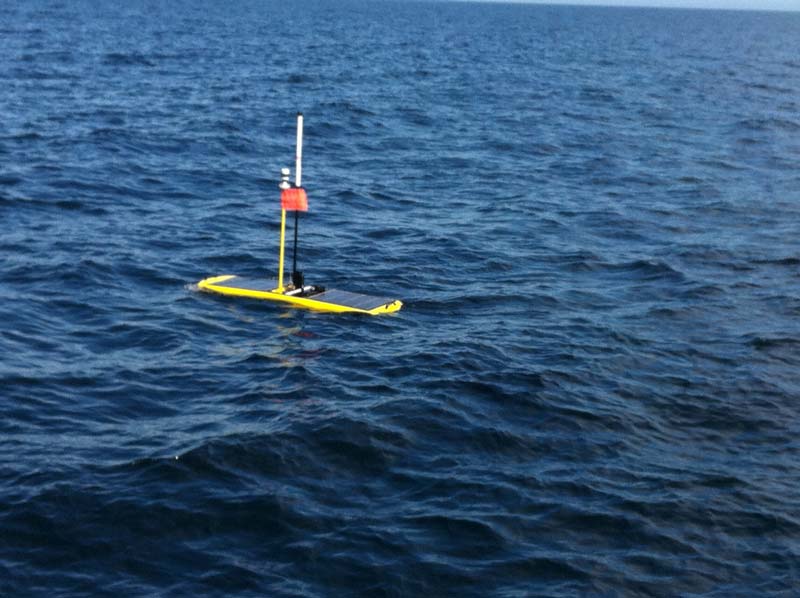This mission was completed on Wednesday, August 22nd with a successful recovery off the coast of Sambro, near Halifax. The glider covered roughly 3150 km over the course of two months at sea, and was able to detect multiple distinct animals in the St. Lawrence as well as near Sable Island. We thank our industrial and academic partners for their help with this successful pilot mission and look forward to continuing research.
Efforts to study Atlantic salmon migration often use acoustic tags to follow fish as they move through the ocean. Salmon smelt and kelts were tagged and released in 2012 from various rivers along the New Brunswick and Quebec coast, enabling researchers to track their migration. While the fish are known to leave the Gulf of St. Lawrence primarily through the Strait of Belle Isle (between Newfoundland and Quebec) the route they take to get there is unknown.
 The Wave Glider deployed near Stephenville, NL
The Wave Glider deployed near Stephenville, NLTo see whether unmanned ocean vehicles can help us pinpoint the migration route of these salmon, a Liquid Robotics Wave Glider, equipped with a sensitive acoustic receiver manufactured by VEMCO, was deployed in the Gulf northwest of Stephenville, NL on 19 June 2012. The hydrophone will detect tagged fish that are within 400-800m of the glider, and the information is relayed via satellite to an onshore operations center. The Wave Glider will be patrolling an area just north of Stephenville to just south of Bonne Bay for approximately one month. UPDATE: For ease of recovery and to explore other environments likely to have tagged animals, the Wave Glider has made its way through the Cabot Strait to Halifax. It was recovered on Wednesday, August 22nd.
Other acoustically tagged fish including Bluefin tuna and cod are active in the Gulf, and may be detected by the Wave Glider’s acoustic receiver. In addition, the glider is measuring and recording surface ocean physics and meteorological conditions to assist oceanographers in understanding the young salmon’s environment.
Live track of the Wave Glider
- About the Wave Glider:
- Movement is powered by wave motion - See How It Works
- Speeds of up to 2 knots, averaging 1 knot
- Electronic equipment powered by solar panels
- More Information:
- Atlantic Salmon Federation - Salmon in the Strait of Belle Isle
- Live data from the Wave Glider
- In the News:
- OTN Director Fred Whoriskey on CBC's West Coast Morning in NFLD
- New York Times Green Blog - A New Way to Track Fish
- OTN Director Fred Whoriskey on CBC Information Morning in Halifax
- High-tech tracker hits the waves - Chronicle Herald interview w/ Richard Davis
- Solar-powered fish-tracking drone recovered off N.S. - CBC Nova Scotia
- CBC News at 6 w/ Rob North - (WG segment starts at 11:05)
- Global Maritimes - Wave Glider recovered (w/ Brett Ruskin)




